

|
|
|
||||||||
|
|
|||||||||
| Home | Forums | Register | Gallery | FAQ | Calendar |
| Retailers | Community | News/Info | International Retailers | IRC | Today's Posts |
 |
|
|
Thread Tools |
|
|
#1 |
|
Vietnam Operation SNAFU: April 25-26, 2009 - Lanexa, VA
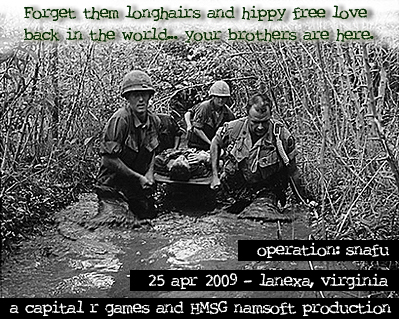 Capital R Games and Historical Military Simulations Group are proud to announce its Vietnam-themed game, "Operation: SNAFU." When: 1200 April 25 - 1200 April 26, 2009 Where: Lanexa, VA Who: US Army infantry for registration only. How Much: $45 pre-registration only, registration now open. Why: Join Foxtrot Company as they get sent into the shit to stir up the hornet's nest. S-2 says that there should be minimal contact with NVA elements but, really, WTF does he know? SNAFU is a 24 hour Vietnam-themed airsoft event that provides attendees with tactics instruction, historical immersion and education, an involved casualty system and a whole different way of looking at airsoft. SNAFU will run from 12 pm Saturday, April 25 until 12 pm Sunday, April 26. The event pits US Army elements, staging out of Firebase Charlie Romeo in the Trang Bang region, against a dedicated People's Army of Vietnam (PAVN) cadre. Attendees will be expected to spend the night in the field at Firebase Charlie Romeo... however, R&R overnight passes may be issued to local players on a case-by-case basis. Anyone issued an R&R pass is expected to be back in formation at 0800 Sunday April 26. Registration is now open for US Infantry players only. This event is a PRE-REGISTRATION game only. You must pre-register before the event and be fully paid in order to attend. Registration fees are non-refundable. Registration closes April 18, 2009. Players must be 18+ years of age with a wavier, 16-17 years of age with a parental signed waiver, 14-15 with a parent attending. But what does your registration fee get you? - 24 hour immersive event with integrated camping. - Field instruction in subjects such as map reading, compass orientation and radio usage. - Operational orders and full briefings with hands-on mission planning. - Chance to win raffle prizes donated by SNAFU event sponsors. - Full BBQ meal at conclusion of event. 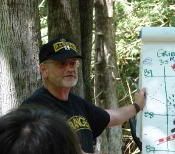 John "REMF" Robison will be part of SNAFU staff, providing much of the instruction. John Robison was briefly enlisted and is a Retired US Army officer and graduate of RANGER school. Jump qualified he also completed the Jungle warfare course in Panama and both the 101st and 9th ID RECONDO schools. He served as the training officer for the 1st Brigade RECONDO school for 3 cycles. He retired from the Army in 1977. Currently he has a training and consulting business and conducts Management and Leadership workshops for a wide variety of clients. He has three grown children and a wife of 62 years. (31 for her and 31 for him) He resides in Sammamish Washington where he collects WW2 uniforms and equipment and builds replica Airsoft Garands as a hobby. 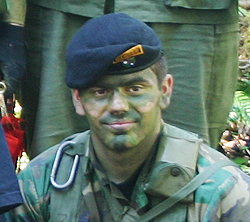 Josh "Ranger" Warren will be part of SNAFU's staff as Captain of Foxtrot Company. Josh is a former U.S Army Ranger serving from 2001-2005 with C Company 2nd Ranger Battalion. Josh served 5 combat tours during his service in support of the Global War on Terror in both Iraq and Afghanistan. He is now in a commissioning program and will be commissioned as an Infantry officer in the U.S Army in the summer of 2009. He has been reenacting since he was 13 starting with the Revolutionary War and eventually moving to both Vietnam and WWII. He has been organizing events in the Pacific Northwest since 2006 as a member of Battlesim. Other notable SNAFU staff will be announced as soon as their attendance is confirmed. SNAFU is a themed event, thus it has stricter uniform and equipment requirements than your average airsoft event. Having such rules helps set the mood and mentality of the game. Most items required for SNAFU are readily available in military surplus stores, sporting goods stores and online and for low cost. We will also have a limited supply of gear available for a small rental fee. UNIFORM REQUIREMENTS 1. US Infantry # Olive Drab BDUs. Slant pockets not required but preferred. # Any ALICE web gear, including M1956, M1968, LC1 and LC2. No modern vests or plate carriers allowed. # Steel pot helmet with Mitchell cover, OD boonie hat, or doorag/bandana for head gear. # M16 with triangle handguards, XM177, any M4 Carbine with carrying handle but no external attachments, or a wood stock M14. Only the M60 is allowed for SAW use. # Anglehead flashlight. Foot Wear The SNAFU Area of Operations has tough variable terrain with lots of undergrowth and fallen foliage. Sturdy foorgear that provides ankle support is required. Black or jungle boots are recommended for US Army. Eye Protection Eye protection that offers ANSI Z 87.1 or higher impact protection is required. This includes tactical goggles, paintball goggles and shooting glasses. Mesh wire goggles are allowed. Eye protection must provide both frontal and side impact protection. BCG glasses are NOT allowed as eye protection. Water All players must have at least one canteen or water-bearing device of water on-person during the game. Drinking water will be provided fand located at the firebase for US Army players. It may not be hot in April in VA, but be sure to hydrate your body at least 2 weeks prior MINIMUM. Safety and Game rules will be posted soon. Be sure to guarantee your spot at the first East coast Namsoft event of the year! Paypal is preferred for your $45 fee to ken.cho@gmail.com. When you pay your registration fee, be sure to include the following information: Name Location (Address, City, State) Age Capital R Games and HMSG look forward to seeing you troops in the shit this April! |
|
|
|

|
|
|
#2 |
|
Operation: SNAFU History and Background
Part 1 - THE MEN OF 101ST AIRBORNE 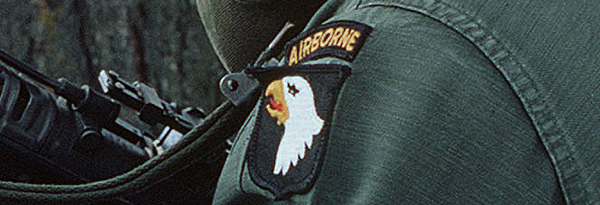 The 101st Infantry Division was famous as an Airborne unit had recently been reinvented as an Air Mobile Division. Most of the soldiers in the Division were airborne qualified and a great deal of pride was attached to that fact. Officers were all graduates of both Airborne and Ranger school as were virtually all senior NCOs. A number of senior NCOs and Officers were WW2 or Korean War veterans.  The Air Mobile concept was designed around the capacity of the UH1B "Huey" helicopter which was the workhorse of the Air Mobile concept. The 1st Air Cav was the only true Air Mobile Unit in the world but the 101st was, for all practical purposes, equal to it in capability. The assets assigned were only sufficient to support a brigade of the 101st at the recommended levels, so for most of its deployment in Vietnam, the three brigades rotated assignment in-country with one or two brigades refitting and retraining state-side while one or, on occasion, two brigades on their rotation in-theater. 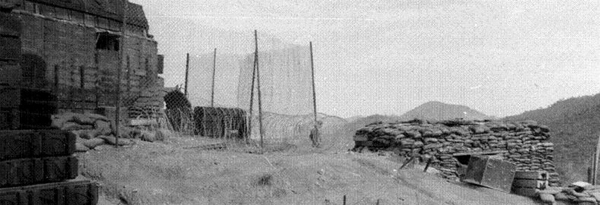 While in the Republic of Vietnam, the units operated as a separate brigade, much like the 173rd or 196th Infantry Brigade. In 1969-70, the 1st Brigade of the 101st was in-country. The division home throughout much of its assignment in Vietnam was at Phu Bai (south and to the east of Hue). The unit itself was housed at Camp Eagle. The base camp location was on a flat, open plain. Though hastily constructed, it had all the facilities to support the brigade when not in the bush. It was the equivalent of a small town and had the rough appearance of a Western boom town. NCO Clubs, Officers Club, PX and small concession outlets were sprinkled throughout. An airstrip for fixed-wing aircraft was present as were numerous landing pads for helicopters. Control towers, communications bunkers, radar towers and lots of large antenna were scattered about. Sandbagged fighting positions ringed the perimiter and bunkers were sprinkle d throughout to serve as shelters for protection against rocket and mortar attacks. Hootches and structures were heavily sandbagged in many but not all cases. Metal Conex Boxes were everywhere and served as semi-secured storage. Vehicles, latrines, concertina wire and lots of Olive Drab kept anyone from thinking they were state-side. The heat and humidity was stifling and the smell of rotting vegetation and diesel fuel was everywhere. 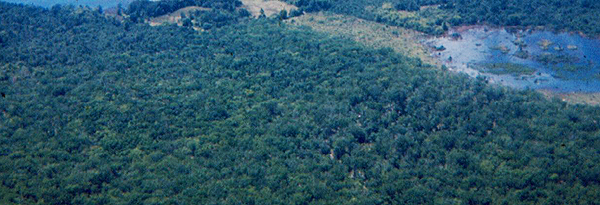 Compared to life in the bush, however, it was heaven. In the immediate area of the Central Highlands, there were a series of steep heavily jungled mountains These could be reached in just a few minutes of flight in a helicopter. The jungle was often triple layer canopy and the rugged terrain was at times deeply cut with streams and deep ravines. 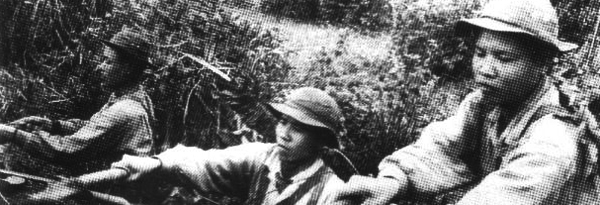 These areas provided the North Vietnamese Army (NVA) with ideal locations for infiltration and sanctuaries. These steep and dense jungles were home to numerous enemy units and well established bases. These units received a constant infusion of fresh troops from the north and supported operations by the NVA command. The troops were battle hardened, well trained and well supplied. Unlike the Viet Cong, which was a localized guerrilla force, the NVA was capable of full blown tactical operations at company and regimental level. 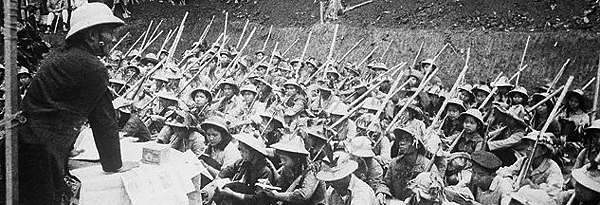 They were the backbone of strategic efforts in the south. The NVA's goal was to generate enough casualties against the allied forces to fracture domestic support for the war. Following the Tet Offensive in 1968, this strategy was clearly their best avenue for success. They chose engagements that favored them by virtue of terrain and sheer numbers of surprise. They did everything they could to keep the division S-2 from recognizing the location of their headquarters elements and logistical bases. The NVA constantly attempted to entice the US to areas not occupied by their forces and locations where the terrain and circumstances favored them. They were very very skilled and dedicated soldiers with proven tactics. |
|
|
|

|
|
|
#3 |
|
Operation: SNAFU History and Background
Part 2 - LONG RANGE RECONNAISSANCE PATROL 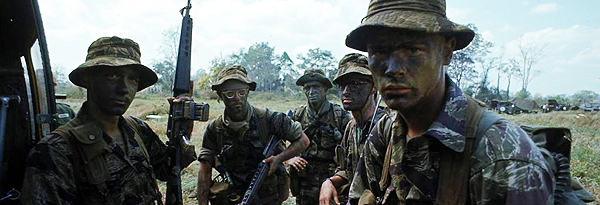 Assigned to the 1st Brigade of the 101st was the 58th Infantry which consisted of a Long Range Recon Company (Company L). At this point in the war, all LRRP units were transitioning to the formation of RANGER companies underthe umbrella of the 75th RANGER Regiment but they continued to operate in support of their parent Divisions. The units consisted of patrols of initially four-man units but by this point in the war they had generally transitioned to six-man elements. http://www.apricot.com/~luuluu/airso.../history08.jpg LRRP teams operated deep inside the enemy sanctuary areas with the primary mission of serving as the "Eyes of the Eagle." Their mission was to provide timely information in support of main force operations. They were almost entirely inserted by helicopter but also were on occasion inserted by vehicle. Traditional elements likewise were usually delivered by helicopter but also were frequently deployed by truck. The NVA was acutely aware of recon efforts and deployed trail watchers and scouts who observed likely landing zones. In extremely sensitive areas, they employed counter-LRRP elements. 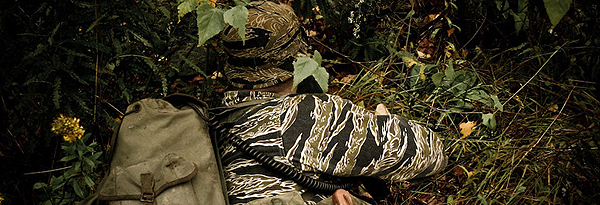 Typical missions for L Co 58th Infantry (LRRP) consisted of point- and area-recons, prisoner snatches, stay behind missions and trail watches. They also manned radio relay positions and, on rare occasions, created heavy teams of 10 to 12 men for daylight or nighttime ambushes. They also secured downed aircraft to facilitate rescue or recovery missions. The teams also sometimes removed sensitive equipment from downed aircraft.  Main force elements of the 101st would often go on two and three week sortees into the bush to perform search and seizure missions, traditional "hammer and anvil" operations, area denial missions and simple missions of opportunity developed by the LRRP teams. In addition to wide ranging operations, the "Lurps" also performed security duties in and around both the main fire bases and night defensive positions (NDP). *Images history09.jpg and history10.jpg are copyright works of David Hintze |
|
|
|

|
|
|
#4 |
|
|

|
  |
|
||||||
| Bookmarks |
| Thread Tools | |
|
|
 |